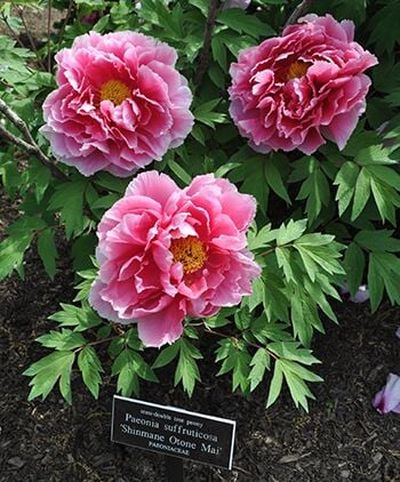Gardening: Peonies

Several years ago, I fell in love with peonies, particularly Itoh peonies. Sometimes described as the “prom queens of the garden,” I love how their bold upright growth topped with their equally bold flowers fill in the early June garden.
These hardy plants provide a structural backdrop for many of the early spring flowers and their foliage continues that structure through the summer. The only care they need is the annual cleanup of last year’s foliage, a little pruning, a little fertilizer in the spring and a moderate amount of water during the hottest part of the summer. The perfect plant.
There are three types of peonies available on the market. Herbaceous peonies that die to the ground in the fall, tree peonies that are woody and don’t die back and a hybrid of the two called the Itoh peony after their Japanese breeder. Herbaceous peonies are common in the nurseries in the spring. The plants grow from a tuberous root with pink growing eyes at the top of the clump. The plants grow 3 to 4 feet tall and wide and require staking to keep them from flopping over when in bloom. The plants bloom in shades of pink, red, orange, yellow and white with a few bicolored ones. The blooms can be simple with a single ring of petals or double with multiple layers of petals. They bloom here in early June. The best time to move them is in the fall.
Tree peonies are deciduous woody shrubs that grow larger than the herbaceous peonies to as much as 5 feet tall with age. This makes them more of a structural plant in the garden year-round. Their flowers come in the same color range as the herbaceous peonies but are as much as 10 inches in diameter. They are best planted in the spring or fall in a place where they don’t compete with other plants and can be left as they don’t like to be transplanted. They are not cut down in the fall and the only pruning they need is to remove dead or damaged branches. They benefit from an application of iron sulfate in the spring. While the labels will say plant in full sun, they do best here with some afternoon shade against our hot sun.
The Itoh peonies were developed by Toichi Itoh, a Japanese nurseryman in 1948, but weren’t introduced until 1974. This plant is a cross between herbaceous and tree peonies and called an intersectional peony. They have a compact growth habit reaching about 3 feet square and die to the ground in the fall. Unlike the herbaceous peony, their sturdy upright stems do not require staking.
Originally, they only were yellow in color, but breeders have expanded their color range to coral, red, pink and white, and their original yellow. Several of them come in a base color streaked with other colors. Itoh peonies usually command a higher price than other peonies. They do well in full sun to afternoon shade.